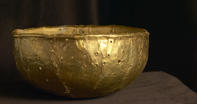The East Coast was Bustling
By the end of the first millennium of the Common Era, the east coast of Africa was bustling. Arab and Asian seafarers had discovered the seasonal trade winds, which enabled them to sail up and down the African shore where they snapped up animal skins, gold and ivory from the locals.

Several trading stations were subsequently established at places such as Zanzibar, Mogadishu, Madagascar and Kilwa, creating a marine trade network that predated the European voyages of discovery by over 500 years.
The most southerly trading station was Sofala, located near the modern-day city of Beira, in Mozambique. As such, teams of African porters from the interior would carry their trade goods to the coast, where it was exchanged for glass beads, cowrie shells and the occasional piece of porcelain from the Far East.
The Mapungubwe Civilisation

Since the Limpopo region contained healthy supplies of wild elephants for ivory as well as nuggets of alluvial gold in the rivers, several tribes in the region became very prosperous. Gradually, these early entrepreneurs began to develop a sophisticated civilisation based on personal wealth and status.
Fortunately, at the time, the climate was in a benevolent phase and the developing kingdoms were bolstered by fertile lands and bountiful herds. A prominent centre of this mercantile Iron Age culture was located several hundred kilometres to the north-west of the Kruger National Park, near the junction of the Limpopo and Shashe rivers.
By 1200, this society had developed into a considerable empire, exerting an influence over several hundred square kilometres in what is now the cross-border region between Botswana, Zimbabwe and South Africa. Known today as the Mapungubwe civilisation, the capital city was built around a distinctive flat-topped hill on the southern side of the Limpopo River.
On the summit of the hill lived the king and a small entourage. At the foot of the hill lived several thousand citizens, who literally looked up at their king as a sacred being.
Mapungubwe Past

For 100 years, the people living around Mapungubwe Hill flourished. Then, quite suddenly, the civilisation collapsed. It does not appear as if the hill was invaded by an external force, but climate change and drought may have forced the people to move on. Whatever the case, circa 1290, Mapungubwe was abruptly abandoned.
African tribes who subsequently lived in the area considered the hill to be taboo. It was said to be the home of ancestors and cursed would be the man who attempted to climb the hill. Mapungubwe was therefore shunned and the story of its people remained shrouded in mystery for 700 years.
It was only in the 1930s that white farmers in the area heard of the forbidden hill and, unconcerned with native superstition, climbed up its steep flanks. Their re-discovery of several royal graves on the hilltop, complete with golden grave goods, sparked off a 70-year excavation that is still ongoing.
Mapungubwe Mysteries

A Uniquely African Moment

Mapungubwe is the first national park to be dedicated to a uniquely African moment; one which celebrates a history that was once denied or dismissed. But it’s about more than just politics.
Mapungubwe is proving to be popular because it is a fantastic place to visit. The scenery is unusual and distinctive. The rest camps are outstanding. And the park also contains the three important archaeological sites of Mapungubwe Hill, K2 and Schroda.
By David Fleminger